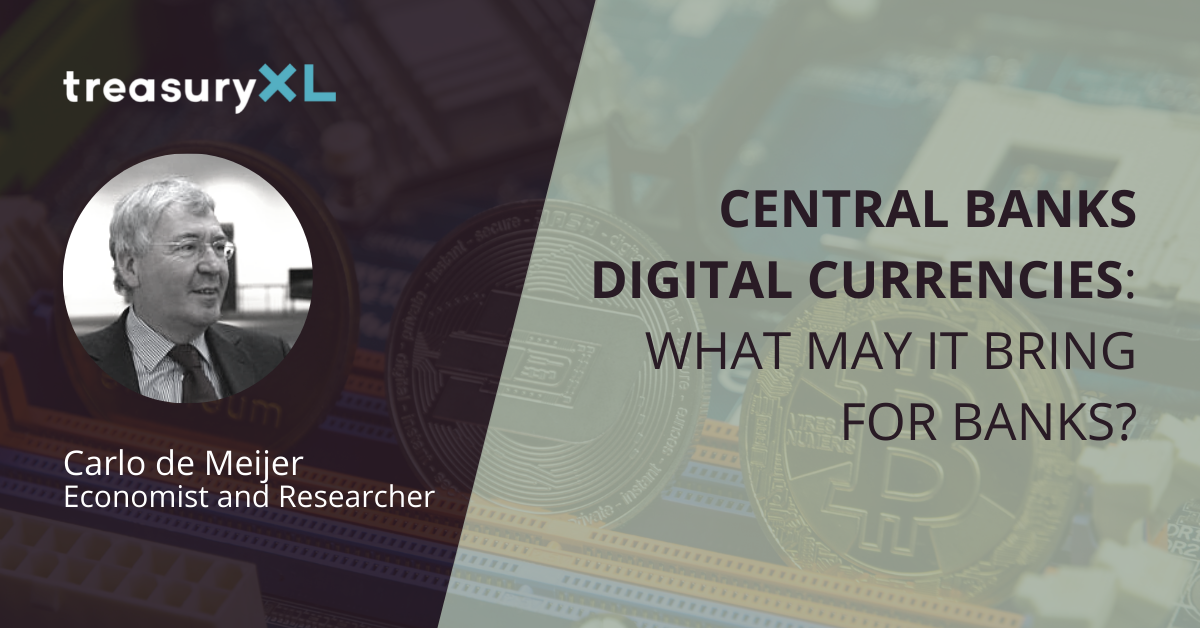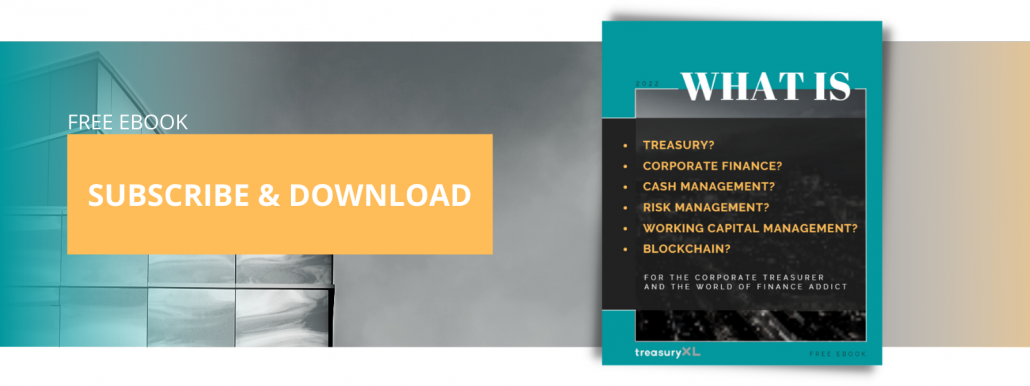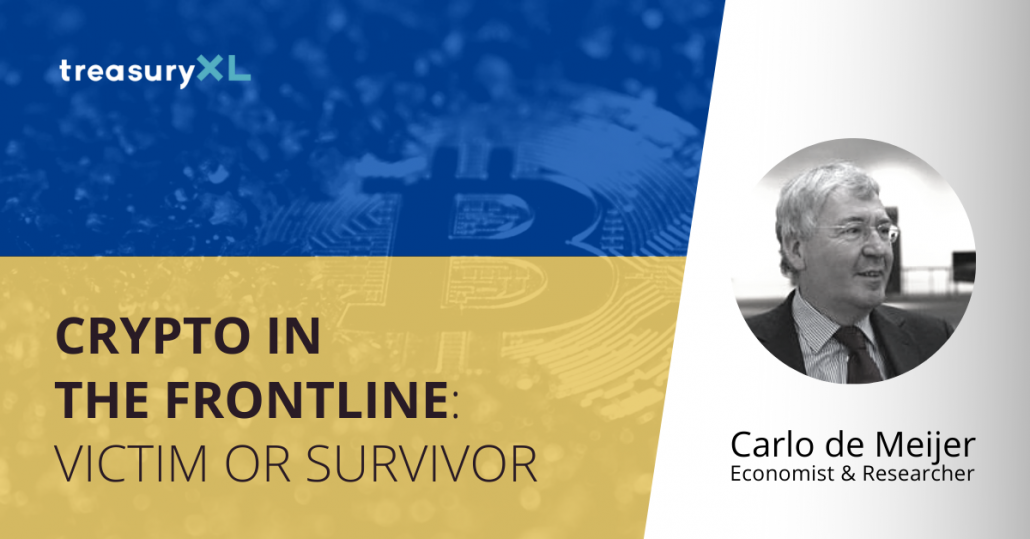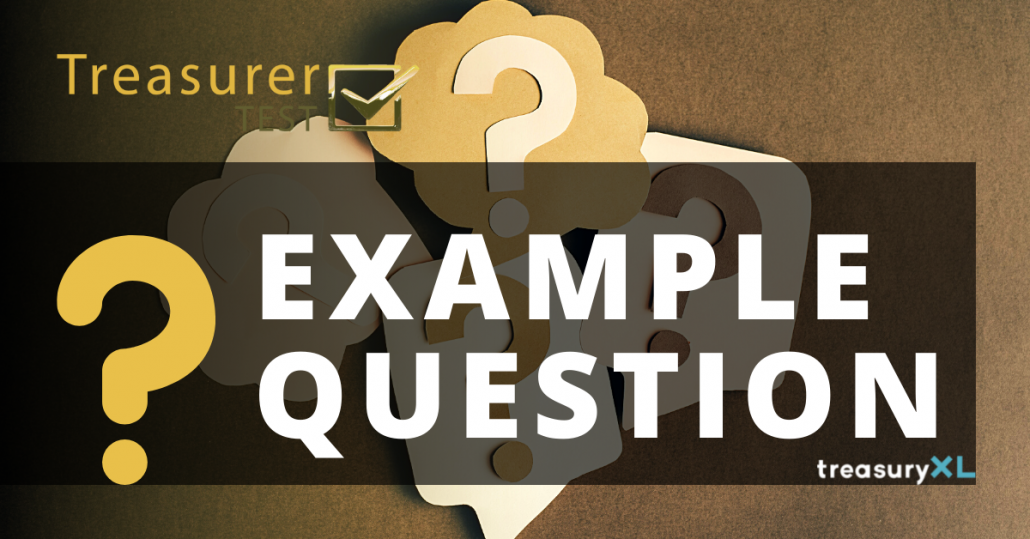Unstable stable coins: how to regulate?
29-06-2022 | Carlo de Meijer | treasuryXL | LinkedIn |
The crypto market was shocked by the sudden collapse of the third largest stablecoin TerraUSD early May. Long-time isolated from the falls in crypto coins like Bitcoin and Ethereum, stablecoins were designed to sidestep crypto volatility and supposed to remain stable across the crypto ecosystem.
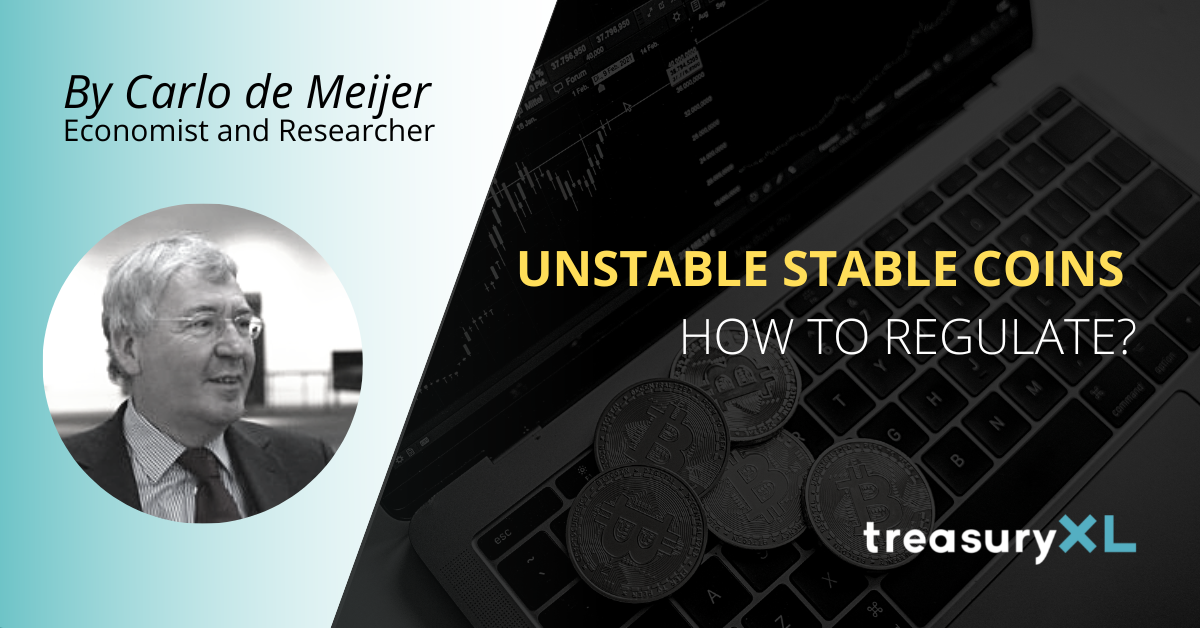
The significant crash of TerraUSD that lost more than 90% of their value in a few days and the resulting crypto market turmoil however has put stablecoins in the regulatory spotlights. Regulators worldwide are prompting new calls for regulation highlighting the risk of certain cryptocurrencies and especially algorithmic stablecoins.
In this blog I want to highlight why TerraUSD, also called UST, dropped below its target value, what the risks are of the various stablecoins, how regulators should react and what investors can learn from the crash of TerraUSD.
TerraUSD collapse
TerraUSD, also called UST, a so-called algorithmic stablecoin, had been another popular option for cryptocurrencies and was even the third largest stablecoin in the world at the threshold of the collapse. That system appeared to work well until then.
But TerraUSD was not able to withstand a panic outburst amongst investors, this notwithstanding they were providing a 20% interest. Sparked by a massive drop in the value of the crypto markets overall, investors lost faith resulting in a mass sell-off in the TerraUSD stablecoin. Luna Foundation Guard (LFG) tried to stop this slide by liquidating part of its 10 billion Bitcoin holdings.
The collateral, partly existing of Bitcoin, was insufficient to maintain its one to one peg to the dollar. As a result it slipped far from its $1 target price and dropped in value beginning May 9, 2022, hitting a low value of $0.015 at the time of publication of this blog.
As of this writing, the combined market capitalization of TerraUSD and partner stablecoin Luna was just over $4.5 billion, indicating a market decline of approximately $14 billion.
How did the markets react?
Cryptocurrencies
In the wake of the TerraUSD collapse, other signs of the crypto sector’s vulnerabilities have emerged. When the Luna Foundation Guard sold almost its entire holdings of Bitcoin following the crash early May, as a result the price of Bitcoin, that lost already more than half of its value since last November from $64.000, sank to a 16-month low below $28.000 per coin. But also other cryptocurrencies were hit, triggered by higher inflation and fears of raising interest rates. TerraUSD’s woes contributed to a slide in crypto markets that saw over $357 billion or more than 30% of digital asset market capitalization wiped out week-on-week.
Stablecoins
While the TerraUSD collapse has spelled trouble for Bitcoin and other cryptocurrencies, the chaos is somewhat contained in the stablecoin sector. That especially goes for the fiat collateralised segment, where most of the stablecoins such as Tether and Binance have the backing of actual cash and other valuable assets. TerraUSD is however different from most of its stablecoin peers.
Investors fled TerraUSD into more trusted stablecoins such as DAI and USDC, which drove the price of TerraUSD further down. This increased demand for DAI and USDC temporarily increased their price and were shortly after arbitraged back to $1.
DeFi
The failure of TerraUSD’s peg already has sent shocks through the decentralised finance (DeFi) sector, with a key saving and lending protocol, Anchor, seeing massive liquidation of TerraUSD-collateralised loans and the pricing of other crypto tokens also being affected. This has led to further liquidation triggers throughout the ecosystem. ‘Bouts’ of volatility will probably continue as the cryptosector digests the repercussions of the failure of the TerraUSD peg, while US policy rate increases and equity volatility may pressure so-called ‘high-beta assets’.
Regulated financial markets
Recently the Financial Stability Board (FSB) pointed to the increased intertwining of the crypto world with the traditional financial world. Up till recently links between crypto markets and regulated financial markets remained weak. The potential for crypto market volatility to spill over and cause wider financial instability was limited. But that has changed.
A growing number of regulated financial entities have increased their exposure to cryptocurrencies, DeFi and other forms of digital finance in recent months. If crypto market volatility becomes severe the risks for the financial stability of the real economy could as a result escalate.
But not all stablecoins are the same
Stable coins are cryptocurrencies designed to be protected from the wild volatility of crypto currencies like Bitcoin and Ethereum. They attempt to maintain a constant exchange rate with fiat currencies, mostly through a 1:1 US dollar peg.
Stablecoins are often used for transactions within the crypto world and between cryptocurrencies and the traditional financial system. They have played a crucial role for cryptocurrency traders, allowing them to hedge against spikes in Bitcoin’s price or to store idle cash without transferring it back into fiat currency.
Regulators should however be aware that not all stable coins are the same. Some stablecoins are more vulnerable than others. The stablecoin sector is a critical and complex part of the crypto ecosystem. Stable coins are an umbrella term. They are not a monolithic asset class and every stablecoin operates differently.
Stablecoin models
Stablecoins can be divided into two broad groups based on how they choose to pursue price stability: collateralised stablecoins and non-collateralised stable coins. Collateralised stablecoins can be split into fiat-collateralised and crypto–collateralised. The newest group of non-collateralised stablecoins are so-called algorithmic stablecoins like TerraUSD.
Fiat collateralised
The value of fiat-collateralised stablecoins is backed by reserves comprising assets, such as fiat currency, mostly the dollar, as collateral assuring stablecoin’s value. Collateral can also consist of bonds, commercial paper, commodities like gold and silver as well as crude oil. But most fiat-collateralised stablecoins have reserves of US dollars.
Dollar-based collateralised stablecoins like Tether and true USDC use a more fluid collection of traditional assets to secure its stable coin. Most of these reserves consist of treasury bills, certificates of deposit, and cash deposits to match the value of outstanding tokens that are maintained by independent custodians and audited regularly to ensure that holders of these stablecoins guarantee they can redeem them for actual fiat money, at some point.
Crypto-collateralised
Another category of stablecoins are crypto-collateralised stablecoins, with their underlying collateral being another cryptocurrency or basket of cryptocurrencies. Because the reserve cryptocurrency may be subject to high volatility, such stablecoins are often over-collateralised, whereby the value of cryptocurrency held in reserves exceeds the value of the stablecoins issued. The Dai stablecoin for instance which is pegged to the US dollar uses a basket of crypto assets as collateral at a ratio of 150% of the value.
Non-collateralised stable coins
And there is the newest group of stablecoins which are algorithmic or ‘decentralised’ stablecoin. While most stablecoins are reserve backed and are supposed to always be exchanged for one dollar, algorithmic stablecoins ‘forgo this failsafe’ and attempt to maintain their pegs through other means. Their primary distinction from collateralised stablecoins is the strategy of keeping the value of their stablecoin by controlling the supply through an algorithm and smart contracts to control the supply of tokens.
TerraUSD (UST)
TerraUSD, which trades with the symbol UST, is one of those algorithmic or decentralised stablecoins. To get somewhat more insights in this new type of stablecoin, let’s go more deeply into how it works.
The purpose of TerraUSD was to create a “crypto-native” dollar – with all of the supposed benefits of blockchains, like censorship resistance – that would be cheaper to use than a fully or partially collateralized option. It was intended to be worth exactly one dollar, enabling transactions to process with predictable results and giving cryptocurrency investors and traders an option to store their assets in cryptocurrency without the risk and volatility associated with typical digital currencies. Its peg to the dollar was supposed to be maintained by a complex algorithmically driven mechanism rather than by reserves of dollars or other assets, as is typical for stablecoins.
As TerraUSD’s popularity took off, its partner stablecoin Luna increased in value as well. The coin popped from around $5 in July 2021 to a high of $116 in early April 2022. Before its collapse TerraUSD was the third-largest stablecoin by market capitalization with about $18 billion and the largest algorithmic stablecoin.
How does TerraUSD work?
TerraUSD as an algorithmic stablecoin, is fundamentally different from most of its peers. Their value is assured not by financial collateral in the traditional markets – though owner Kwo diversified earlier this year their backing by purchasing $10 billion in Bitcoin – but backed by lines of computer code so-called algorithms to stay pegged to the dollar.
This stablecoin used a sophisticated but complex automated system of arbitrage to maintain its valuation at the 1:1 level. This mechanism relies on two coins: the TerraUSD stablecoin and the Luna governance token. It involved swapping TerraUSD coins with this free-floating cryptocurrency Luna to control supply.
The value-protecting transactions are executed by smart contracts on the Terra network. A computer algorithm thereby creates (mints) and destroys (burns) both TerraUSD and Luna to bring the price back into equilibrium. When the price of TerraUSD drops below $1, traders can burn TerraUSD—removing it from circulation, thereby reducing the overall supply —and raise the price back up. If the value of TerraUSD goes higher than $1, traders can burn Luna for TerraUSD, increasing the overall supply and lowering the price. This creates trading margins and supply and demand models that help keep the coin pegged to $1.
Another key part of the Terra ecosystem is the interest rates on TerraUSD deposits. These are offered through Anchor Protocol, a decentralized finance (DeFi) platform, which can garner annual percentage yield rates of 20 percent on TerraUSD tokens that could be borrowed by investors in need of dollar-like capital. The Terra decentralized finance (DeFi) network incentivized traders, holders, and users to either use, lend, or stake these crypto assets. This system worked reasonably well in practice from the inception up till early May.
Regulations
As things stand nowadays, stablecoins are very lightly regulated. A significant part lays outside the control of regulators. Given the explosive growth of the $130 billion market and its potential to affect the broader financial system, it is not strange that stablecoins have come under growing scrutiny by regulators. The recent turmoil has reignited calls in virtually every major financial market in the world for increased regulation of the crypto asset market in general and of stablecoins in particular.
Common themes in the discussions are the volatility, the lack of transparency with regards to crypto operations and the reserves they are supposed to hold, the overly optimistic promised returns and investors that are not well informed with regards to what is being purchased.
Reactions
Politicians have increased calls for tighter regulation of stablecoins. The falls in cryptocurrencies and the collapsing value of TerraUSD have further alarmed policymakers in both the EU and the US such as Treasury Secretary Janet Yellen and Securities and Exchange Commission Chair Gary Gensler.
US Treasury Janet Allen
US Secretary of the Treasury Janet Yellen has cited risks to broad financial stability due to stablecoins. She told a Senate Committee that the TerraUSD debacle has reinforced the need for proper oversight and for a “consistent federal framework” for regulating stablecoins and said that stablecoin guidance could come as early as this year.
“A stablecoin known as TerraUSD experienced a run and declined in value” “I think that this simply illustrates that this is a rapidly growing product and there are rapidly growing risks.” Janet Yellen
Fed semi-annual Stability Report
In its recent published semi-annual Stability Report, the Fed discussed the uncertainty of what is actually backing stablecoins and the lack of oversight in that market. The Fed repeated its concerns that stablecoins are vulnerable to investor runs because they are backed by assets that can lose value or become illiquid in times of market stress. The increasing use of stablecoins to meet margin requirements in leveraged crypto trades may further heighten redemption risks. A lack of transparency around the assets may exacerbate those vulnerabilities. A run on the stablecoin could therefore spill over into the traditional financial system by creating stress on these underlying assets, according to the report.
What sort of regulation
There are however still different visions on how to regulate stablecoins. Some regulators are preparing rules for stablecoins to make them look and function more like banks. Some others come up with proposed regulation that will look like more as governance tokens being considered securities. According to them, as tokens have claims against assets, or claims against cash flows, they are looked at the easiest target for regulators.
The International Organization of Securities Commissions (IOSCO) said stablecoins should be regulated as financial market infrastructure like banks alongside payment systems and clearinghouses. The proposed rules should focus on stablecoins deemed systemically important by regulators, with the potential to disrupt payment and settlement transactions.
The ECB is also increasingly worried about the risks for the financial stability of crypto investments. They are urgently calling for accelerating the implementation and acceptance of regulation to implement constraints to crypto currencies and stable coins. The EU’s Markets in Crypto Assets regulation, that would enter into force from 2024 onwards, is expected not not permit the issuance of algorithmic stablecoins and would require crypto providers to have a (bank-like) license and systemic stablecoin issuers be backed by enough reserves.
What issues for regulators to consider?
There are important lessons to be learned from this crypto collapse, that regulators should keep in mind when designing legal frameworks for cryptocurrencies in general and for stablecoins in particular.
Like all new technologies, these assets — including dollar-backed, crypto-collateralized and algorithmic models — deserve a smart and thoughtful conversation around potential regulation, in order notto frustrate financial innovations.
Regulators should thereby be aware that this collapse of TerraUSD is not a reflection of all stablecoins, because they weren’t all built the same under the same philosophy. As has been described before algorithmic stablecoins are very different compared to the collateralised stablecoin types.
Stablecoins in general should therefore not be forbidden but should be firmly regulated to prevent that a collapse like TerraUSD will happen again. Buyers should understand what the risk are especially of these algorithmic stable coins. It therefore needs standards
Factors to keep in mind for regulators
There are a number of important factors policymakers and investors should keep in mind as stablecoins continue to develop and mature. This latter group take deposits without any insurance that customers rely upon to know their money is protected.
Regulators should likely pay more scrutiny to the risks surrounding stablecoins and their reserve attestations especially algorithmic stablecoins, given that UST’s problems have sparked wider crypto market volatility.
Stablecoins backed by reserve assets with clear fiat currency value however face a fundamentally different set of credit issues to algorithmic stablecoins, in our view. In such cases, the stablecoin’s stability risks can be more manageable, depending on various factors, notably the safety and liquidity of the reserve assets.
Asset-backed stablecoins therefore should become transparent about what is in their reserves. With traditional stablecoins, regulators also want to know that their operators have sufficient assets to pay out customers in the case of a run on the system.
Factors relevant to the credit profiles of issuers of reserve-backed stablecoins should include regulatory risk, counterparty risk (including reserve custodians), transparency over reserves and the extent to which the underlying assets are truly uncorrelated, the legal rights of stablecoin holders, as well as governance and operational risks.
In the case of algorithmic stablecoins, they should, in regulatory terms, not be [backed] one-to-one, but being over-collateralized because these are inherently more risky. Other issues to keep in mind that are relevant for regulators are: what are the permissible reserves?; who can issue a stablecoin?; how should an issuer and the reserved be audited?; and, what kind of disclosures are made to consumers?”
Factors relevant to the credit profiles of issuers of reserve-backed stablecoins should include regulatory risk, counterparty risk (including reserve custodians), transparency over reserves and the extent to which the underlying assets are truly uncorrelated, the legal rights of stablecoin holders, as well as governance and operational risks.
Final remarks
It is clear that regulation of stablecoins is urgently needed to prevent collapses like that of TerraUSD. There are still many open questions.
It is however still unclear how this new regulation will look like and what impact this new upcoming regulation will have for the future of stable coins in general and algorithmic stablecoins specifically. But also what would it mean for the further development of underlying technologies.
What is clear is that stablecoins are here to stay but in a more regulated framework. It does seem very likely that many more investors will choose collateralized stablecoins in the future. This will most likely result in a growing number of stablecoins with lower risks.
In the end this may further benefit the crypto industry as thanks to lower risks and increased transparency it may attract more players from the traditional financial world.
Carlo de Meijer
Economist and researcher


